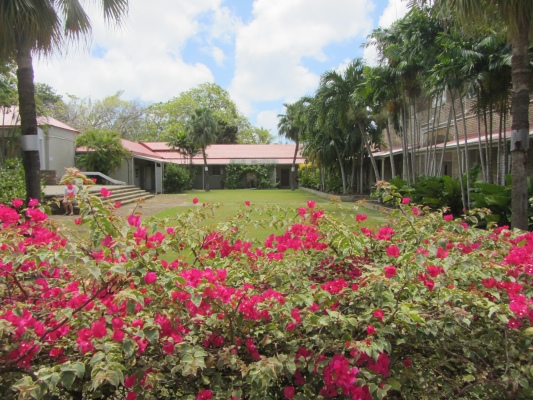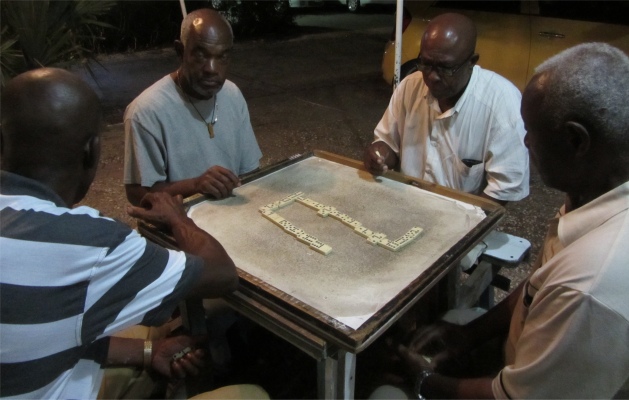The builders slowly arrived in dribs and drabs for their daily toil; there seemed to be no fixed start and end time on the building site. The two large cranes that towered over the hotel development site lazily rotated on their spindly legs, not unlike their avian counterparts, delivering concrete and other materials across the site. I was impressed that they kept working despite the ravages of wind and downpours that battered them. The next fleet of European aircraft were still traversing the Atlantic, probably crossing the Azores at this time of day.
 Barbados Museum & Historical Society |
The museum's exhibits are displayed in a series of galleries set in former cells, covering the history of the island, the colonial era, slavery, emancipation, the military, geography, nature, rare historical maps, and 18th century plantation house furniture.
The Jubilee Gallery set the scene of the early development of the island. The earliest inhabitants were the Amerindians who were settled in the area between 350 to 650AD. They had arrived from Venezuela. Paddling long dugout canoes, they crossed a narrow sea channel from the Orinoco Basin, called the Dragon's Mouth, which acts as a funnel to the Caribbean Sea and the nearest island of Trinidad. A second wave of settlers, the Arawaks, appeared around the year 800. The Arawaks were short, olive-skinned people who bound their foreheads during infancy to slope it into a point. They considered this along with black and white body painting to be attractive. They were an agricultural people and grew cotton, cassava, corn, peanuts, guavas, and papaws (papaya). In the mid-13th century, the Arawaks were conquered by the Caribs. The Caribs were a taller and stronger Amerindian tribe than the Arawaks, and were politically more organised. The Caribs in turn abandoned the island close to the arrival of the first Europeans.
The Portuguese visited the island in 1536, en route to Brazil. It was at this time that the island was named Los Barbados (bearded-ones) by the Portuguese explorer Pedro a Campos. It was so named, presumably, after the island's fig trees, which have a beard-like appearance.
The English first landed on the island on 14th May 1625 under the command of Captain John Powell. The island was therefore claimed on behalf of King James I. On 17th February 1627, Captain Henry Powell landed with a party of 80 settlers and 10 slaves to occupy and settle the island. This expedition landed in Holetown, formerly known as Jamestown. The colonists established a House of Assembly in 1639. It was the third ever Parliamentary Democracy in the world.
People with good financial backgrounds and social connections with England were allocated land. Within a few years much of the land had been deforested to make way for tobacco and cotton plantations. During the 1630s, sugar cane was introduced to the agriculture. The production of sugar, tobacco and cotton was heavily reliant on the indenture of servants. White civilians who wanted to emigrate overseas could do so by signing an agreement to serve a planter in Barbados for a period of 5 or 7 years. To meet the labour demands, servants were also derived from kidnapping, and convicted criminals were shipped to Barbados. Descendants of the white slaves and indentured labour (referred to as Red Legs) still live in Barbados. They live amongst the black population in St. Martin's River and other east coast regions. At one time they lived in caves in this region.
 Flowers in Barbados Museum Courtyard |
The initial establishment of tobacco, cotton and indigo production slipped by the wayside when it was realised that the U.S. southern states were producing those goods more economically. The Bajan climate and soil was ideally suited to sugar cane. The Bajans dominated the Caribbean Sugar Industry in these early years. Indeed Barbados is widely regarded as the first British colony to undergo a "Sugar Revolution," meaning that the entire island's resources (land and labour) were committed to sugar production by the mid-1640s. This was helped by the sugar plantation owners, who were powerful and successful businessmen who had arrived in Barbados in the early years. However, by 1720, Bajans were no longer a dominant force within the sugar industry. They had been surpassed by the Leeward Islands and Jamaica.
After slavery was abolished in 1834, many of the new citizens of Barbados took advantage of the superb education available on the island. After these citizens had been educated, they wanted something more than working in the cane fields. Some of them gained prominent offices in Barbados. Others worked in common jobs, and still others stayed in the cane fields. A 4-year apprenticeship period was introduced, during which free men continued to work a 45-hour week without pay in exchange for living in the tiny huts provided by the plantation owners. Another interesting book I read, "In the Castle of my Skin" by George Lamming, gives an interesting glimpse of life on the island at this time. Freedom from slavery was celebrated in 1838 at the end of the apprenticeship period with over 70,000 Bajans of African descent taking to the streets with the Barbados folk song:
"Lick an Lock-up Done Wid, Hurray fuh Jin-Jin (Queen Victoria).
De Queen come from England to set we free
Now Lick an Lock-up Done Wid, Hurray fuh Jin-Jin"
Barbados was first occupied by the British in 1627 and remained a British colony until internal autonomy was granted in 1961. The island gained full independence in 1966, and maintains ties to the British monarch represented in Barbados by the Governor General. It is a member of the Commonwealth. The first leader of Barbados as a free nation was the Right Honourable Errol Walton Barrow, of the Democratic Labour Party.
Unlike other Caribbean islands, Barbados maintains its sugar industry, although the majority of the economy is now based on tourism and offshore banking. The rate of condos being built along the western seafront is limited purely by the speed at which concrete dries.
I found the historical traces in the Jubilee Gallery highly informative; I was totally absorbed by it. This gallery naturally led straight into the Harewood Gallery. This covered the ecology of the coral reef, of mangrove swamps and of sea grasses. The fishing industry, turtles and their protection and the harvesting of sea-eggs (urchins) are all examined in the exhibits and are all topics that continue to be relevant today. Emphasis is placed on increasing knowledge of Barbados' natural environment and its protection. Species of animals that are now extinct and those which are endangered are on display. The migratory birds which visit Barbados annually are also featured.
This led on to the African Gallery, which explores the rise of early humanity and the geography, history and heritage of Africa and its legacy in the creation of Caribbean society. The exhibition entitled "Connections and Continuities" highlights the geographical and demographic diversity of the continent. Four outstanding African kingdoms were also covered, together with the symbols of power employed at both secular and religious levels.
The Military Gallery details the historical development of the armed forces from the 17th century until the end of World War II. The gallery allowed one to view the significant military milestones of the island from militias utilised in the 17th century to the development of the Barbados Defence Force in the 1970s. The development of the second oldest regiment in the Commonwealth is covered, as is the island's development into the Headquarters of the British Navy and Army in the Caribbean in the 18th and 19th centuries, and the sacrifice of its people in both World Wars. Military regalia, armaments, medals and photographs and the list of names of those Bajan servicemen who lost their lives in World War I and II are all on display.
Our final port of call in the museum was the Cunard Gallery, which features a wide collection of 65 prints bequeathed to the Museum by Sir Edward Cunard, a collector of West Indian prints. Some of the finest West Indian prints are those by military artists Lieut. J. H. Caddy, whose depictions of coastal and interior landscape scenes of St. Lucia, St. Vincent, Dominica and St. Kitts are skilfully executed in a picturesque series of coloured aquatints; and Lieut. J. M. Carters' series of ten lithographs which deal exclusively with Bajan landscape, typically of buildings, landscapes and street scenes mainly in and around the garrison area.



